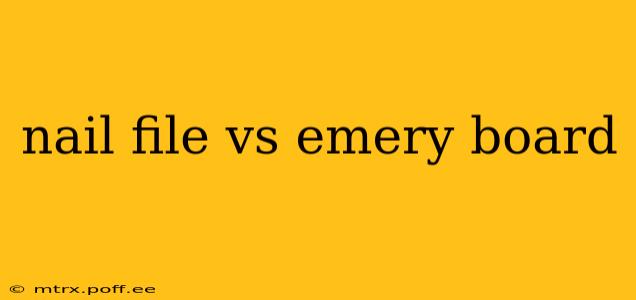Choosing between a nail file and an emery board might seem trivial, but understanding the differences can significantly impact your manicure routine and nail health. Both tools shape and smooth nails, but their composition and effectiveness vary considerably. This guide will clarify the distinctions, helping you select the ideal tool for your needs.
What is a Nail File?
A nail file is a tool used to shape and smooth nails. They come in various materials, grits (the coarseness of the filing surface), and shapes. Common materials include metal, glass, and various types of abrasive paper or plastic. Metal files are generally the most durable but require a lighter touch to prevent damage to the nail. Glass files are gentler and are often considered better for fragile nails. Files made of abrasive paper or plastic come in a wide range of grits, allowing for precise control over shaping and smoothing.
What is an Emery Board?
An emery board is a type of nail file, specifically one made from cardboard or wood coated with an abrasive material, usually emery powder. They are typically disposable and are often found in inexpensive manicure sets. Emery boards are known for their affordability and ease of use, but they tend to be less durable and less precise than other types of nail files.
Nail File vs. Emery Board: Key Differences
| Feature | Nail File | Emery Board |
|---|---|---|
| Material | Metal, glass, plastic, paper | Cardboard or wood with emery powder coating |
| Durability | High (metal, glass) to low (paper/plastic) | Low |
| Precision | High (metal, glass) to moderate (paper/plastic) | Moderate to Low |
| Cost | Varies widely | Generally inexpensive |
| Grit Options | Wide range of grits available | Usually only a few, limited grit options |
| Gentle on Nails | Glass files are the gentlest, metal and plastic can cause damage if used improperly. | Can be harsh on nails if used improperly. |
What is the Best Nail File for Natural Nails?
For natural nails, a glass file or a fine-grit (high number, e.g., 240 grit) sand board are recommended. Glass files are incredibly gentle and reduce the risk of nail splitting or peeling. Fine-grit files are best for smoothing and refining the nail shape after initially shaping with a coarser file. Avoid metal files on natural nails, unless you're experienced and use extreme caution.
What is the Best Nail File for Acrylic Nails?
Acrylic nails generally require a more robust file. A coarser grit (lower number, e.g., 100-180 grit) nail file, usually made of plastic or a metal file can be used to shape the acrylic, but be careful not to apply too much pressure. Always file in one direction to avoid creating uneven surfaces. A fine-grit file can be used for smoothing and buffing.
How to Use a Nail File Properly?
Regardless of the type of nail file you use, proper technique is crucial for nail health:
- File in one direction: Always file in a single direction, avoiding back-and-forth sawing motions. This prevents the nail from splitting and fraying.
- Use gentle pressure: Avoid excessive pressure, especially with metal or coarser files.
- File the free edge only: Don't file the surface of the nail. Focus on shaping the free edge (the part that extends beyond the fingertip).
- Keep files clean: Clean your files regularly to prevent the spread of bacteria.
Are Emery Boards Bad for Your Nails?
Emery boards themselves aren't inherently "bad" for your nails. However, because they tend to be less durable and their grit is often less controlled, they can cause damage if used improperly or if they become worn and uneven. Using too much pressure or a back-and-forth filing motion can lead to splitting, peeling, and weakening of the nails.
Choosing between a nail file and an emery board ultimately depends on your individual needs and preferences. Understanding the differences in material, durability, and precision will allow you to select the best tool for maintaining healthy and beautiful nails. Remember to always use proper filing techniques to prevent damage.
